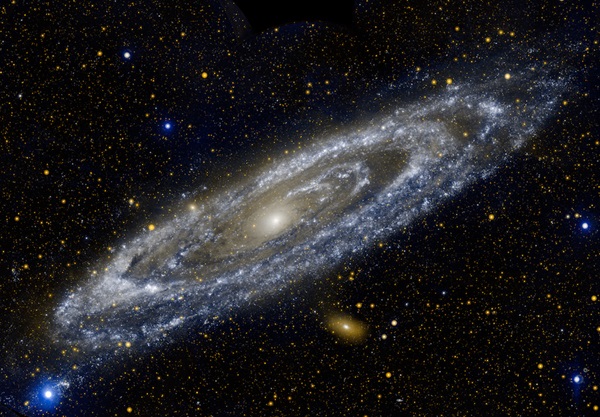Key Takeaways:
- Andromeda galaxy's mass is similar to the Milky Way's.
- Scientists used star escape velocity to measure Andromeda's mass.
- Andromeda contains less dark matter than previously believed.
- The Milky Way's collision with Andromeda needs further study.
Because astronomers previously thought that Andromeda was up to three times as massive as the Milky Way, they expected that our galaxy would be easily overpowered and absorbed into our larger neighbor. But now, new research suggests we’ve overestimated our opponent.
In a study published today in the Monthly Notices of the Royal Astronomical Society, a team of Australian astronomers announced that Andromeda is not actually the heavyweight we once thought it was. Instead, they found that our nearest galactic neighbor is more or less the same mass as the Milky Way — some 800 billion times the mass of the Sun.
To determine the heft of the Andromeda galaxy, the team used a technique that calculates the speed required for a quick-moving star to escape the gravitational pull of its host galaxy. This required speed needed for ejection is known as an object’s escape velocity.
“When a rocket is launched into space, it is thrown out with a speed of [6.8 miles per second (11 kilometers per second)] to overcome the Earth’s gravitational pull,” said Prajwal Kafle, an astrophysicist from the University of Western Australia branch of the International Centre for Radio Astronomy Research, in a press release. “Our home galaxy, the Milky Way, is over a trillion times heavier than our tiny planet Earth, so to escape its gravitational pull, we have to launch with a speed of [342 miles per second (550 kilometers per second)]. We used this technique to tie down the mass of Andromeda.”
This is not the first time a galaxy’s weight has been recalculated based on analyzing the escape velocities of objects within it. In 2014, Kafle used a similar technique to revise down the mass of the Milky Way, showing that our galaxy has much less dark matter — a mysterious form of matter that has gravity but does not interact with light — than previously thought.
The nearby galaxy Andromeda will eventually (in about 4 to 5 billion years) merge with our own galaxy, the Milky Way. Although the Milky Way has not been involved in any recent large mergers, astronomers have observed the remnants of many previous smaller mergers.
NASA/ESA/F. Summers/G. Besla/R. van der Marel
Much like the 2014 study showed for the Milky Way, today’s paper suggests that previous research has overestimated the amount of dark matter present in the Andromeda galaxy. “By examining the orbits of high-speed stars, we discovered that [Andromeda] has far less dark matter than previously thought,” said Kafle, “and only a third of that uncovered in previous observations.”
Although revising down Andromeda’s overall mass may seem like it should help the Milky Way out during the galaxies’ eventual collision, the researchers say that new simulations are first needed to determine exactly what will happen when the galaxies meet. But no matter what happens in 4 billion years, Kafle says today’s new finding “completely transforms our understanding of the local group.”
For now, however, we can take solace in the newfound knowledge that the Milky Way is not nearly as overpowered by Andromeda as we once thought. As University of Sydney astrophysicist Geraint Lewis said, “We can put this gravitational arms race to rest.”










